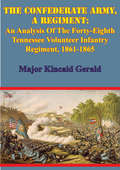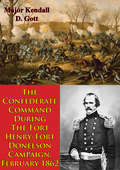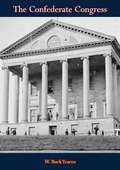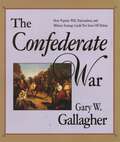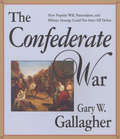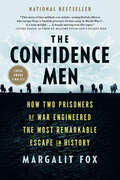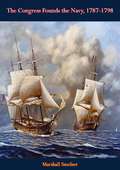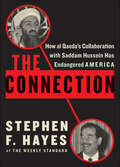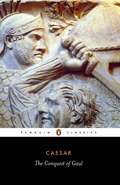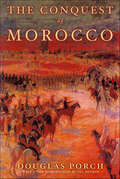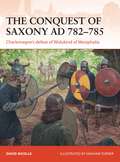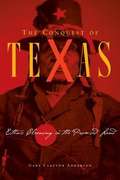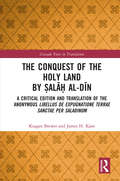- Table View
- List View
The Confederate Approach on Harrisburg: The Gettysburg Campaign's Northernmost Reaches (Sesquicentennial Series)
by Cooper H. WingertThe little-known story of how Southern forces came close to invading the capital of Pennsylvania—includes photos. In June 1863, Harrisburg braced for an invasion. The Confederate troops of Lt. Gen. Richard S. Ewell steadily moved toward the Pennsylvania capital. Capturing Carlisle en route, Ewell sent forth a brigade of cavalry under Brigadier Gen. Albert Gallatin Jenkins. After occupying Mechanicsburg for two days, Jenkins&’s troops skirmished with Union militia near Harrisburg. Jenkins then reported back to Ewell that Harrisburg was vulnerable. Ewell, however, received orders from army commander Robert E. Lee to concentrate southward—toward Gettysburg—immediately. Left in front of Harrisburg, Jenkins had to fight his way out at the Battle of Sporting Hill. The following day, Jeb Stuart&’s Confederate cavalry made its way to Carlisle and began the infamous shelling of its Union defenders and civilian population. Running out of ammunition and finally making contact with Lee, Stuart also retired south toward Gettysburg. In this enlightening history, author Cooper H. Wingert traces the Confederates to the gates of Harrisburg in these northernmost actions of the Gettysburg Campaign.
The Confederate Army, A Regiment: An Analysis Of The Forty-Eighth Tennessee Volunteer Infantry Regiment, 1861-1865
by Major Kincaid GeraldThe performance of an army is often evaluated by its achievements as a whole, or by that of its commanders or perhaps even its divisions. Often lost in the equation is the small unit. After the great plans are complete and the logistics preparations are accomplished, it is the collective performance of the small unit that ultimately decides the battle.This thesis analyses the campaigns, soldiers, organization, equipment, and performance of just one regiment: the 48th Tennessee Volunteer Infantry. Material concerning the 48th includes numerous primary sources: the Official Records, Confederate Veteran, The Southern Historical Papers, Southern Bivouac, local histories, and the CARL microfiche library of unit histories (Note: the 48th is not included in these unit histories). Other primary references include war diaries of two officers, three enlisted men, and copies of the 48th's Quartermaster records.This thesis concludes that, while training and equipment of the 48th was sometimes poor, it was effective in numerous engagements, despite its relative small size. The ultimate demise of the unit was due to personnel losses.
The Confederate Battle Flag: America's Most Embattled Emblem
by John M. CoskiIn recent years, the Confederate flag has become as much a news item as a Civil War relic. Intense public debates have erupted over Confederate flags flying atop state capitols, being incorporated into state flags, waving from dormitory windows, or adorning the T-shirts and jeans of public school children. To some, this piece of cloth is a symbol of white supremacy and enduring racial injustice; to others, it represents a rich Southern heritage and an essential link to a glorious past. Polarizing Americans, these "flag wars" reveal the profound--and still unhealed--schisms that have plagued the country since the Civil War. The Confederate Battle Flag is the first comprehensive history of this contested symbol. Transcending conventional partisanship, John Coski reveals the flag's origins as one of many banners unfurled on the battlefields of the Civil War. He shows how it emerged as the preeminent representation of the Confederacy and was transformed into a cultural icon from Reconstruction on, becoming an aggressively racist symbol only after World War II and during the Civil Rights movement. We gain unique insight into the fine line between the flag's use as a historical emblem and as an invocation of the Confederate nation and all it stood for. Pursuing the flag's conflicting meanings, Coski suggests how this provocative artifact, which has been viewed with pride, fear, anger, nostalgia, and disgust, might ultimately provide Americans with the common ground of a shared and complex history.
The Confederate Command During The Fort Henry-Fort Donelson Campaign, February 1862
by Major Kendall D. GottThis study investigates the decisive factors that affected the Fort Henry-Fort Donelson campaign in February 1862. The thesis is relevant not only to the study of history, but as a series of lessons for all commanders.In the final analysis, the ultimate failure of the Confederates during this campaign can be attributed directly to the actions of General Albert Sidney Johnston. He failed to develop an adequate strategy to meet the expected invasion from the North or to insure that each subordinate command in his department was prepared for the onslaught. Johnston also failed to establish a command structure to support his Department. Most damaging of all, Johnston neglected the defenses of the Tennessee and Cumberland rivers, which served as invasion routes through the center of his departmentIronically, one of the worst generals of the Confederacy correctly saw Fort Donelson as the key to stopping Grant and protecting Nashville. Had he been better supported by his superiors and by the officers serving at the fort with him, the Confederates may have won a victory at Fort Donelson and secured the Western Department for several months.
The Confederate Congress
by W. Buck YearnsPublished in 1960, this study of the Confederate Congress and its relation to the Jefferson Davis administration describes the legislation, debates, personalities, and politics of this turbulent time. Initially, the Confederate Congress and President Davis were in agreement on how to win the war and lawmaking proceeded in a routine manner. However, as the war progressed conflicts arose as Congress and the President were faced with the difficulties of providing a poor nation with the facilities to combat a richer one. Much of the later legislation was written only after bitter political controversy. An appendix gives brief biographical data on the Confederate congressmen, including their voting records.-Print ed.
The Confederate Fiddle
by Jeanne WilliamsA Civil War Story of High Adventure In 1863 Brownsville, Texas, was the only port open to the South. Vin Clayburn joins a wagon train in Missouri taking cotton, the Confederacy's money crop, to the Brownsville port for export to France, England, and Germany. This deeply moving and adventurous book is a story of loyalty— the devotion of Vin Clayburn to home and belief—even to the sacrifice of a prized family violin. Vin longs to be like his dashing older brother in the Confederate Army instead of a driver in a cotton train traveling from Missouri to Brownsville. Though he is determined to see it through, he resents the routine job of carrying supplies and missing "a hero's glory." He learns, however, that his unglamorous task involves thrills, courage and daring and—even more difficult—understanding and respect for those whose views are different from his own. Most of all, in a compelling climax, Vin comes to realize that there are many different kinds of heroes.
The Confederate Nation: 1861 To 1865 (The New American Nation Series)
by Emory M. Thomas“Incisive and insightful. . . . As good a short history of the Southern war effort as we have.” —T. Harry Williams, Pulitzer Prize–winning author of Lincoln and His GeneralsEmory M. Thomas’s critically acclaimed chronicle of the Confederacy remains widely recognized as the standard history of the South during the Civil War. Now with a new introduction by the author, The Confederate Nation presents a highly readable, highly personal portrait of the Southern experience during these years. Thomas, renowned for his illuminating biographies of Robert E. Lee and other Southern generals, here delivers the definitive account of the political and military events that shook the nation during its period of greatest turmoil.“The Confederate Nation has yet to be superseded as the standard title on the subject.” —Journal of Southern History“A serious, scholarly, readable work.” —C. Vann Woodward, The New Republic“One of America’s most eminent Civil War historians.” —Richmond Times-Dispatch
The Confederate Resurgence of 1864 (Conflicting Worlds: New Dimensions of the American Civil War)
by William MarvelWilliam Marvel’s The Confederate Resurgence of 1864 examines a dozen understudied Confederate and Union military operations carried out during the winter and spring of 1864 that, taken cumulatively, greatly revived white southerners’ hopes for independence. Among the pivotal moments during this period were the sinking of the USS Housatonic by the CSS Hunley; Nathan Bedford Forrest’s defeat of William Sooy Smith’s cavalry raid; and the Confederate army’s victory at Olustee, Florida. The repulse of Union advances on Dalton, Georgia; botched Union raids on Richmond; and the capture of the Union garrison in Plymouth, North Carolina, likewise suggested that the tide of fighting had turned toward the Confederate cause. These events boosted the morale of southern troops and citizens, and caused grave concerns about the war effort in the North and in the mind of Abraham Lincoln.In late 1863 and early 1864, dejection and despair prevailed in the South: Union soldiers had vanquished Robert E. Lee at Gettysburg, the Confederate nation had been cut in two, Tennessee was lost, and Braxton Bragg’s army had been utterly routed at Chattanooga. Defeatism loomed in the South during the first weeks of 1864, and the ease with which William T. Sherman rampaged across Mississippi illustrated the dominance of Union forces, while Confederates’ ineffectual assault on New Bern accentuated their weakness. Yet between February 20 and April 30, southern troops enjoyed an unbroken string of successes that included turning back a concerted Union offensive during the Red River campaign as well as Forrest’s incursions into Union City, Paducah, and Fort Pillow. Aided by flawed strategy implemented by Union army officers, the achievements of Confederate forces restored hope and confidence in camp and on the southern home front. The Confederacy’s battlefield successes during the early months of 1864 remained almost unnoticed by Civil War scholars until recently and have never been studied collectively for their impact on Confederate morale. The victories invigorated southern combatants, demonstrating how abruptly the most dismal military prospects could be reversed. Without that experience, Marvel argues, the Confederates who faced Sherman and Grant in the spring of that year would certainly have displayed less ferocity and likely would have succumbed more quickly to the demoralization that ultimately led to the collapse of Confederate resistance.
The Confederate War
by Gary GallagherThis book argues that we should not ask why the Confederacy collapsed so soon, but rather how it lasted so long. The book re-examines the Confederate experience through the actions and words of the people who lived it, to show how the home front responded to the war, endured great hardships and assembled armies that fought with spirit and determination.
The Confederate War (American Civil War Classics Ser.)
by Gary W. GallagherIf one is to believe contemporary historians, the South never had a chance. Many allege that the Confederacy lost the Civil War because of internal division or civilian disaffection; others point to flawed military strategy or ambivalence over slavery. But, argues distinguished historian Gary Gallagher, we should not ask why the Confederacy collapsed so soon but rather how it lasted so long. In The Confederate War he reexamines the Confederate experience through the actions and words of the people who lived it to show how the home front responded to the war, endured great hardships, and assembled armies that fought with tremendous spirit and determination. Gallagher’s portrait highlights a powerful sense of Confederate patriotism and unity in the face of a determined adversary. Drawing on letters, diaries, and newspapers of the day, he shows that Southerners held not only an unflagging belief in their way of life, which sustained them to the bitter end, but also a widespread expectation of victory and a strong popular will closely attuned to military events. In fact, the army’s “offensive-defensive” strategy came remarkably close to triumph, claims Gallagher—in contrast to the many historians who believe that a more purely defensive strategy or a guerrilla resistance could have won the war for the South. To understand why the South lost, Gallagher says we need look no further than the war itself: after a long struggle that brought enormous loss of life and property, Southerners finally realized that they had been beaten on the battlefield. Gallagher’s interpretation of the Confederates and their cause boldly challenges current historical thinking and invites readers to reconsider their own conceptions of the American Civil War.
The Confidence Men: How Two Prisoners of War Engineered the Most Remarkable Escape in History
by Margalit FoxThe astonishing true story of two World War I prisoners who pulled off one of the most ingenious escapes of all time.&“A wonder, a marvel, a feat of invention and dogged persistence, and most of all, a testament to the power of the human capacity to believe.&”—Liza Mundy, author of Code Girls: The Untold Story of the American Women Code Breakers of World War II Imprisoned in a remote Turkish POW camp during World War I, having survived a two-month forced march and a terrifying shootout in the desert, two British officers, Harry Jones and Cedric Hill, join forces to bamboozle their iron-fisted captors. To stave off despair and boredom, Jones takes a handmade Ouija board and fakes elaborate séances for his fellow prisoners. Word gets around, and one day an Ottoman official approaches Jones with a query: Could Jones contact the spirit world to find a vast treasure rumored to be buried nearby? Jones, a trained lawyer, and Hill, a brilliant magician, use the Ouija board—and their keen understanding of the psychology of deception—to build a trap for their captors that will ultimately lead them to freedom. A gripping nonfiction thriller, The Confidence Men is the story of one of the only known con games played for a good cause—and of a profound but unlikely friendship. Had it not been for &“the Great War,&” Jones, the Oxford-educated son of a British lord, and Hill, a mechanic on an Australian sheep ranch, would never have met. But in pain, loneliness, hunger, and isolation, they formed a powerful emotional and intellectual alliance that saved both of their lives. Margalit Fox brings her &“nose for interesting facts, the ability to construct a taut narrative arc, and a Dickens-level gift for concisely conveying personality&” (Kathryn Schulz, New York) to this tale of psychological strategy that is rife with cunning, danger, and moments of high farce that rival anything in Catch-22.
The Conflict in Syria and the Failure of International Law to Protect People Globally: Mass Atrocities, Enforced Disappearances and Arbitrary Detentions
by Jeremy Julian SarkinThis book explores, through the lens of the conflict in Syria, why international law and the United Nations have failed to halt conflict and massive human rights violations in many places around the world which has allowed tens of millions of people to be killed and hundreds of millions more to be harmed. The work presents a critical socio-legal analysis of the failures of international law and the United Nations (UN) to deal with mass atrocities and conflict. It argues that international law, in the way it is set up and operates, falls short in dealing with these issues in many respects. The argument is that international law is state-centred rather than victim-friendly, is, to some extent, outdated, is vague and often difficult to understand and, therefore, at times, hard to apply. While various accountability processes have come to the fore recently, processes do not exist to assist individual victims while the conflict occurs or the abuses are being perpetrated. The book focuses on the problems of international law and the UN and, in the context of the many enforced disappearances and arbitrary detentions in Syria, why nothing has been done to deal with a rogue state that has regularly violated international law. It examines why the responsibility to protect (R2P) has not been applied and why it ought to be used, generally, and in Syria. It uses the Syrian context to evaluate the weaknesses of the system and why reform is needed. It examines the UN institutional mechanisms, the role they play and why a civilian protection system is needed. It examines what mechanism ought to be set up to deal with the possible one million people who have been disappeared and detained in Syria. The book will be a valuable resource for students, academics and policy-makers working in the areas of public international law, international human rights law, political science and peace and security studies.
The Congress Founds the Navy, 1787-1798: 1798
by Marshall SmelserIn this book Professor Smelser seeks to fill the void in the American Naval History—the politics behind the U.S. Navy.“Naval historians have usually given little attention to the political shaping of national naval policy, and political historians (a more numerous species) have generally presented only the final decisions of naval policy without much investigation of the policy-making process.”
The Conjurer's Riddle
by Andrea CremerThe Revolution is beginning–and Charlotte may be on the wrong side. In this sequel to The Inventor's Secret, Charlotte and her companions escape the British Empire, but they haven't left danger behind. In fact, if they go against the revolutionaries, they face even greater peril. Charlotte leads her group of exiles west, plunging into a wild world of shady merchants and surly rivermen on the way to New Orleans. But as Charlotte learns more about the revolution she has championed, she wonders if she's on the right side after all. Charlotte and her friends get to know the mystical New Orleans bayou and deep into the shadowy tunnels below the city–the den of criminals, assassins and pirates–Charlotte must decide if the revolution's goals justify their means, or if some things, like the lives of her friends, are too sacred to sacrifice. This alternate-history adventure series asks the questions: What would have happened if America had lost the Revolutionary War? And what would people be willing to do to finally taste freedom? Praise for The Conjurer's Riddle:"This is classic steampunk [with] exotic and picturesque locales, lots of interesting machinery, and the adrenaline rush of following the adventures of an honest and fearless heroine. A suitably swashbuckling sequel."--Kirkus Reviews"This invigorating series neatly fits into the sagacategory, with loads of adventure, lots of explosions, plenty of pirates, and still some pages left forromance. The dramatic ending sweeps readers right toward the next book."--Booklist "Fans will enjoy seeing Charlotte take on a more serious role as she faces multiple factions while forging her own path."--VOYAPraise for The Inventor's Secret:* "Cremer...creates an inventive blend of steampunk and alternative history in this new series. She gives readers a fantastical world with mechanical wonders and an opulent vintage setting. The characters are interesting and well developed. Readers will be drawn to future installments."--VOYA, starred review"[A]n entertaining romp in a richly imaginative setting."--Kirkus ReviewsFrom the Hardcover edition.
The Connection: How al Qaeda's Collaboration with Saddam Hussein Has Endangered America
by Stephen F. HayesIn the wake of 9/11 no one knew when the next attack would come, or where it would come from. America's enemies seemed gathered on all sides, and for several nerve-racking months, we lived in fear that the perpetrators might be plotting another action or, worse, that our most dangerous enemies -- al Qaeda and Saddam Hussein's murderous regime in Iraq -- could be banding together against us.The Bush administration and CIA director George Tenet warned against complacency and pointed to growing indications that al Qaeda and Iraq were in league. But their case was undercut by unnamed intelligence officials, skeptical politicians, and a compliant media. So America relaxed. A comforting consensus settled in: Osama bin Laden was an impassioned fundamentalist, Saddam a secular autocrat. The two would never, could never, work together. ABC News reported that there was no connection between them, and the New York Times said so too, and pretty soon just about everyone agreed.Just about everyone was wrong.In The Connection, Stephen Hayes draws on CIA debriefings, top-secret memos from our national intelligence agencies, and interviews with Iraqi military leaders and Washington insiders to demonstrate that Saddam and bin Laden not only could work together, they did -- a curious relationship that stretches back more than a decade and may include collaboration on terrorist acts, chemical-weapons training, and sheltering some of the world's most wanted radicals.Stephen Hayes's bombshell Weekly Standard piece on this topic was cited by Vice President Cheney as the "best source of information" about the Saddam-al Qaeda connections. Now Hayes delves even deeper, exposing the inner workings of America's deadliest opponents and providing a clear-eyed corrective to reams of underreported, politicized, and just plain wrong information.The Connection is both a gripping snapshot of the War on Terror and a case study in how bureaucratic assumptions and media arrogance can put us all at risk.
The Conquering Tide: War in the Pacific Islands, 1942–1944
by Ian W. TollNew York Times Bestseller The devastation of Pearl Harbor and the American victory at Midway were prelude to a greater challenge: rolling back the vast Japanese Pacific empire, island by island. This masterful history encompasses the heart of the Pacific War—the period between mid-1942 and mid-1944—when parallel Allied counteroffensives north and south of the equator washed over Japan's far-flung island empire like a "conquering tide," concluding with Japan's irreversible strategic defeat in the Marianas. It was the largest, bloodiest, most costly, most technically innovative and logistically complicated amphibious war in history, and it fostered bitter interservice rivalries, leaving wounds that even victory could not heal. Often overlooked, these are the years and fights that decided the Pacific War. Ian W. Toll's battle scenes—in the air, at sea, and in the jungles—are simply riveting. He also takes the reader into the wartime councils in Washington and Tokyo where politics and strategy often collided, and into the struggle to mobilize wartime production, which was the secret of Allied victory. Brilliantly researched, the narrative is propelled and colored by firsthand accounts—letters, diaries, debriefings, and memoirs—that are the raw material of the telling details, shrewd judgment, and penetrating insight of this magisterial history. This volume—continuing the "marvelously readable dramatic narrative" (San Francisco Chronicle) of Pacific Crucible—marks the second installment of the Pacific War Trilogy, which will stand as the first history of the entire Pacific War to be published in at least twenty-five years.
The Conqueror Comes to Tea: Japan under MacArthur
by John La CerdaThe story of Japan is no longer—if it was ever—the delicate words and prints of the travel literature of the nineteenth and early twentieth centuries. A scheme for ruling the world has been followed by a costly war; the war by unconditional surrender; the surrender by occupation. From these tumbling events is emerging the new story, with characters and plots aplenty in the stark, sometimes terrifying and always swiftly moving drama of Japan today. It has all the makings of a novel…
The Conquerors
by Michael R. BeschlossFrom one of America's most respected historians, The Conquerors reveals one of the most important stories of World War II. As Allied soldiers fought the Nazis, Franklin Roosevelt and, later, Harry Truman fought in private with Churchill and Stalin over how to ensure that Germany could never threaten the world again. Eleven years in the writing, drawing on newly opened American, Soviet and British documents as well as private diaries, letters and secret audio recordings, Michael Beschloss's gripping narrative lets us eavesdrop on private conversations and telephone calls among a cast of historical giants. The book casts new light upon Roosevelt's concealment of what America knew about Hitler's war against the Jews and his foot-dragging on saving refugees; FDR's actions so shocked his closest friend in the Cabinet, Secretary of the Treasury Henry Morgenthau, Jr., that Morgenthau risked their friendship by accusing the President of "acquiescence" in the "murder of the Jews." After the Normandy invasion, "obsessed" by what he had learned about the Nazis and the Holocaust, Morgenthau drew up a secret blueprint for the Allies to crush Germany by destroying German mines and factories after the European victory. As The Conquerors shows, FDR endorsed most of Morgenthau's plan, and privately pressured a reluctant Churchill to concur. Horrified, Secretary of State Cordell Hull and Secretary of War Henry Stimson leaked the plan to the press at the zenith of the 1944 campaign. Hitler's propagandist Joseph Goebbels denounced the Roosevelt-Churchill "Jewish murder plan" and claimed it would kill forty-three million Germans. Republican presidential candidate Thomas Dewey charged that by stiffening German resistance, publicity about Morgenthau's plan had cost many U.S. soldiers' lives. The Conquerors explores suspicions that Soviet secret agents manipulated Roosevelt and his officials to do Stalin's bidding on Germany. It reveals new information on FDR's hidden illnesses and how they affected his leadership -- and his private talk about quitting his job during his fourth term and letting Harry Truman become President. It shows us FDR's final dinner, in April 1945, in Warm Springs, Georgia, at which the President and Morgenthau were still arguing over postwar Germany. Finally it shows how the unprepared new President Truman managed to pick up the pieces and push Stalin and Churchill to accede to a bargain that would let the Anglo-Americans block Soviet threats against Western Europe and ensure that the world would not have to fear another Adolf Hitler.
The Conquest Of Okinawa: An Account Of The Sixth Marine Division
by Major Philips D. CarletonContains numerous maps.One of a series of monographs prepared by the Historical Division that deals with the activities of Marine Corps units in World War II, this monograph is the work of Captain Carleton. While on Okinawa he lived with the men of the Sixth Marine Division, watched them fight and listened to their accounts of the action. He was with the Twenty Ninth Marines on Motobu Peninsula, the Twenty Second Marines during the fight for Naha, and spent considerable time with the Sixth Reconnaissance Company.Most of the material in this monograph is the result of Captain Carleton's personal observations or was gained through his interviews with the officers and men who fought in the Okinawa battles.
The Conquest of Gaul
by Julius CaesarBetween 58 and 50BC Caesar conquered most of the area now covered by France, Belgium and Switzerland, and twice invaded Britain. This is the record of his campaigns.Caesar's narrative offers insights into his military strategy & paints a fascinating picture of his encounters with the inhabitant of Gaul and Britain, as well as offering lively portraits of a number of key characters such as the rebel leaders and Gallic chieftains. This can also be read as a piece of political propaganda, as Caesar sets down his version of events for the Roman public, knowing that he faces civil war on his return to Rome.
The Conquest of Morocco: A History
by Douglas PorchThe Conquest of Morocco tells the story of France's last great colonial adventure. At the turn of the twentieth century, Morocco was a nation yet to emerge from the Middle Ages, ruled by local warlords and riven by religious fanaticism. But in the mad scramble for African colonies, Morocco had one great attraction for the Europeans: it was available. In 1903, France undertook to conquer the exotic and backward country. By the time World War I broke out the conquest was virtually complete.Based on extensive original research, The Conquest of Morocco is a splendid work of popular history.
The Conquest of Saxony 782-785 AD
by David Nicolle Graham TurnerCharlemagne's conquest of the Saxons was the hardest fought and most protracted of his wars; it involved 18 campaigns spread across 33 years, a great deal of lower-level fighting and the harshest final peace settlement that Charlemagne ever imposed upon a defeated foe. Rapidly taking on the character of a religious conquest from its outset, it also became the most important of all Charlemagne's wars for the future direction and character of European history and began the long process of uniting the German-speaking peoples. With extensive photographs, full colour artworks, maps and bird's-eye-views, this volume unravels the initial stages of a convoluted sequence of events that led to the conquest of the Saxons and ultimately Charlemagne's consolidation of Saxony into the greater Carolingian Empire.
The Conquest of Texas: Ethnic Cleansing in the Promised Land, 1820-1875
by Gary Clayton AndersonThe Conquest of Texas is the story of the struggle between Anglos and Indians for land. Anderson tells how Scotch-Irish settlers clashed with farming tribes and then challenged the Comanches and Kiowas for their hunting grounds. Next, the decade-long conflict with Mexico merged with war against Indians. For fifty years Texas remained in a virtual state of war. By confronting head-on the romanticized version of Texas history that made heroes out of Houston, Lamar, and Baylor, Anderson helps us understand that the history of the Lone Star state is darker and more complex than the mythmakers allowed.
The Conquest of al-Andalus: A Translation of Fatḥ al-Andalus (Routledge Medieval Translations)
by Jawad Al-Tamimi, AymennThe Conquest of al-Andalus: A Translation of Fatḥ al-Andalus provides the first English-language in-depth study and complete English translation of the work Fatḥ al-Andalus (“The Conquest of al-Andalus”), which covers the history of Muslim Spain from the time of the initial conquest in 711 CE until the rise of the Almoravids and unification of the territories of Muslim Spain. The work is generally thought to be anonymous and likely dates from the early 12th century CE.The introductory study provides a brief overview about the historical period covered by Fatḥ al-Andalus and relevant Arabic historical sources before turning to major themes and historical topics in Fatḥ al-Andalus, such as holy war and conquest, conflicts between Arabs and Berbers, ʿAbd al-Raḥmān I’s establishment of an independent Umayyad emirate in al-Andalus, and the ṭāʾifa realms that emerged in al-Andalus in the 11th century and were then dismantled by the Almoravids. The translation is extensively annotated in order to aid the reader’s understanding of the text, and a special appendix is provided with translations of Latin and Arabic source materials for additional context and comparison.Owing to Fatḥ al-Andalus’ brevity and conciseness, the text serves as an ideal introduction to medieval Arabic historiography about al-Andalus, especially for a more general audience that may not be able to read the original Arabic text, which presents difficulties and has until now only been available in Spanish translations. This volume should also be a helpful companion for specialists who may wish to examine the traditions contained in Fatḥ al-Andalus and compare them with other Arabic historical works about al-Andalus
The Conquest of the Holy Land by Ṣalāḥ al-Dīn: A critical edition and translation of the anonymous Libellus de expugnatione Terrae Sanctae per Saladinum (Crusade Texts in Translation)
by Keagan Brewer James KaneThe Libellus de expugnatione Terrae Sanctae per Saladinum (or Little Book about the Conquest of the Holy Land by Ṣalāḥ al-Dīn) is the most substantial contemporary Latin account of the conquest of the Kingdom of Jerusalem in 1187. Seemingly written by a churchman who was in Jerusalem itself when the city was besieged and captured, the Libellus fuses historical narrative and biblical exegesis in an attempt to recount and interpret the loss of the Holy Land, an event that provoked an outpouring of grief throughout western Christendom and sparked the Third Crusade. This book provides an English translation of the Libellus accompanied by a new, comprehensive critical edition of the Latin text and a detailed study in the introduction.

